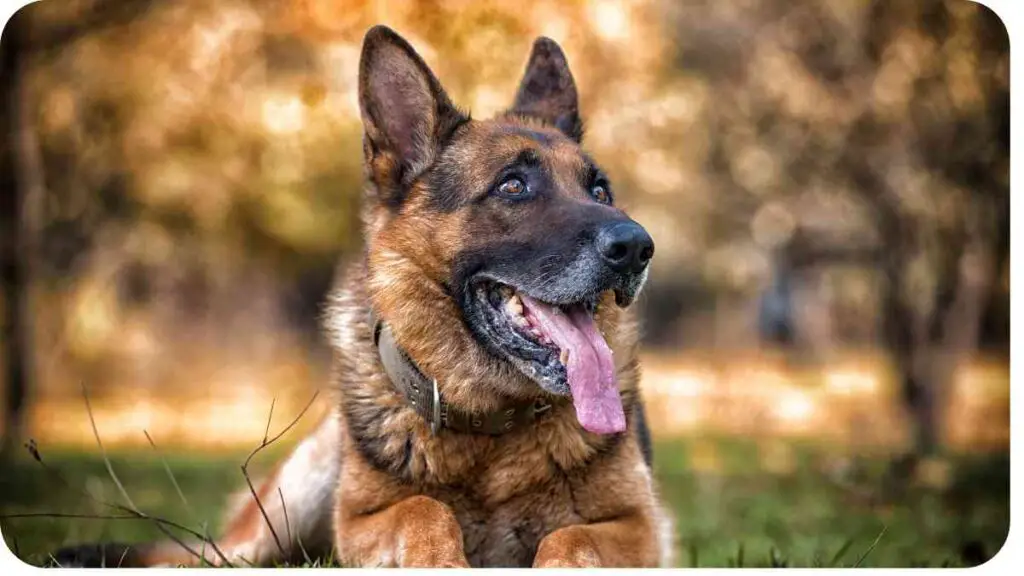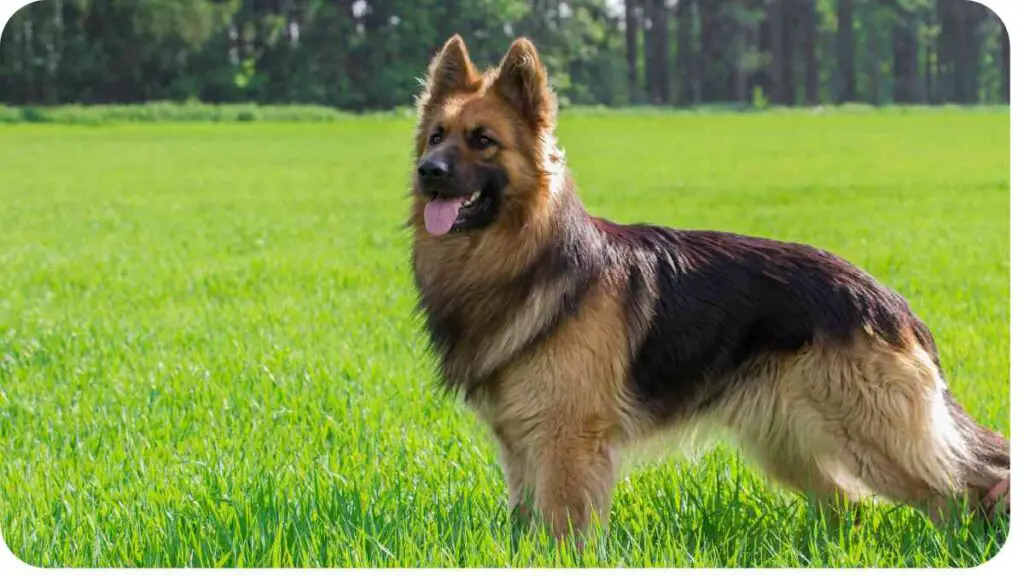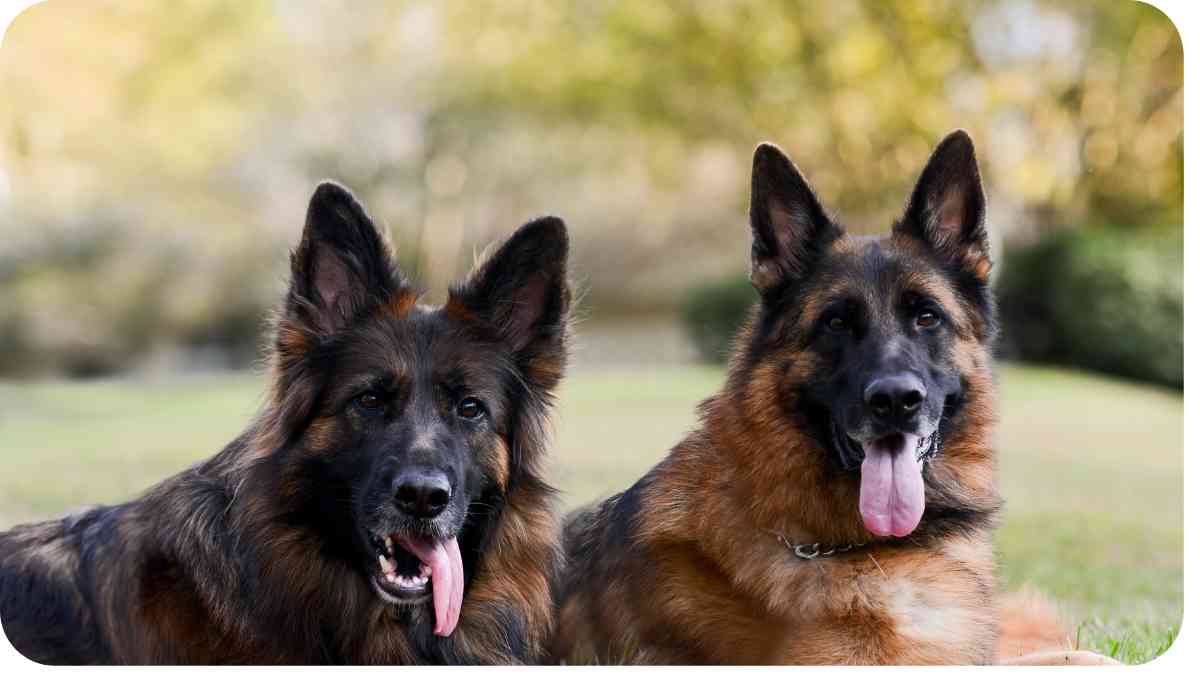German Shepherds, with their noble appearance and exceptional intelligence, have earned a special place in the hearts of dog lovers worldwide. Known for their unwavering loyalty and versatile capabilities, these canines are more than just pets they’re valued members of families, law enforcement agencies, and search-and-rescue teams.
| Key Takeaways |
|---|
| 1. German Shepherds have a rich history tracing back to their origins as herding dogs in 19th-century Germany. |
| 2. Captain Max von Stephanitz played a pivotal role in standardizing the breed and establishing the Verein für Deutsche Schäferhunde. |
| 3. The German Shepherd’s versatility and working abilities make them invaluable assets in various roles, including law enforcement, search and rescue, and therapy work. |
| 4. Responsible breeding practices and regular veterinary care are essential for maintaining the health and well-being of German Shepherds. |
| 5. When choosing a German Shepherd, consider factors such as activity level, living space, training experience, and intended purpose to ensure a compatible match. |
| 6. Proper nutrition, regular exercise, and mental stimulation are vital for fulfilling the needs of German Shepherds and promoting their overall happiness and longevity. |
| 7. Explore additional resources to deepen your understanding of the German Shepherd breed’s history, care, and training. |
Table 1: Quick Facts About German Shepherds
| Trait | Description |
|---|---|
| Origin | Germany |
| Size | Medium to large |
| Lifespan | 9 to 13 years |
| Temperament | Intelligent, loyal, protective, versatile |
| Coat | Double coat, typically tan and black |
| Height | Male: 24 to 26 inches; Female: 22 to 24 inches |
| Weight | Male: 65 to 90 pounds; Female: 50 to 70 pounds |
2. Ancestral Roots: From Sheepherders to Guardians
The roots of the German Shepherd trace back to the pastoral landscapes of 19th-century Germany. As industrialization swept through Europe, the need for efficient herding dogs grew. Enter the ancestors of the modern German Shepherd, bred for their intelligence, agility, and strong work ethic.
German Shepherds embody the essence of family companionship, blending loyalty and affection seamlessly. Discover more about their role as Fun Family Dogs in creating cherished memories.
Table 2: Ancestral Breeds Influencing the German Shepherd
| Ancestral Breed | Characteristics |
|---|---|
| Old German Sheepdog | Hardy, intelligent, skilled at herding |
| Thuringian Shepherd | Agile, adaptable, excellent guarding instincts |
| Württemberg Sheepdog | Strong work ethic, loyal, protective |
These early herding dogs played a vital role in managing flocks, but their duties extended beyond the pastures. They also served as protectors, keeping predators at bay and ensuring the safety of both livestock and handlers.
The selective breeding practices of German farmers and shepherds aimed to enhance desirable traits while maintaining the breed’s working abilities. This meticulous process laid the foundation for what would eventually become the German Shepherd breed we know today.
3. The Story of Captain Max von Stephanitz
The evolution of the German Shepherd as a distinct breed owes much to the vision and dedication of one man: Captain Max von Stephanitz. A former cavalry officer with a keen interest in canines, von Stephanitz attended a dog show in 1899 where he encountered a remarkable dog named Hektor Linksrhein.
Table 3: Key Events in the Life of Max von Stephanitz
| Year | Event |
|---|---|
| 1864 | Birth of Max von Stephanitz |
| 1899 | Discovery of Hektor Linksrhein at a dog show, inspiring the creation of the German Shepherd breed |
| 1899-1901 | Founding of the Verein für Deutsche Schäferhunde (Society for the German Shepherd Dog) |
| 1899 | Registration of Hektor Linksrhein as the first German Shepherd Dog in the breed registry |
| 1936 | Death of Max von Stephanitz at the age of 72 |
Von Stephanitz was captivated by Hektor’s intelligence, athleticism, and steadfast loyalty. Recognizing the potential of this exceptional dog, he embarked on a mission to standardize and refine the breed.
In 1899, von Stephanitz founded the Verein für Deutsche Schäferhunde (Society for the German Shepherd Dog), laying the groundwork for the breed’s development.
Understanding the nuanced behavior of German Shepherds, including occasional biting tendencies, is crucial for effective training and fostering trust. Explore insightful strategies for this breed’s behavior in our guide: Why German Shepherds Sometimes Bite.
Through meticulous breeding and rigorous selection criteria, von Stephanitz sought to create a versatile working dog capable of excelling in various tasks. His efforts resulted in the establishment of the German Shepherd as a distinct breed with recognized standards of appearance and behavior.
4. The First German Shepherd Dog Show

The inaugural German Shepherd Dog show held in 1899 marked a significant milestone in the breed’s history. Organized by Max von Stephanitz, this event provided a platform to showcase the capabilities and potential of these remarkable dogs.
Table 4: Highlights of the First German Shepherd Dog Show
| Event | Description |
|---|---|
| Date | April 22, 1899 |
| Location | Karlsruhe, Germany |
| Participants | German Shepherds from various regions of Germany |
| Purpose | To evaluate and promote the breed’s qualities and working abilities |
| Recognition | Hektor Linksrhein, owned by Max von Stephanitz, recognized as the progenitor of the breed |
The success of the first German Shepherd Dog show helped cement the breed’s reputation as a versatile and capable working dog. Judges assessed the dogs based on criteria such as conformation, temperament, and agility, ensuring that breeding efforts remained focused on producing dogs with exceptional qualities.
The event also provided breed enthusiasts with an opportunity to exchange knowledge, share breeding practices, and discuss the future direction of the German Shepherd breed. It laid the foundation for future dog shows and competitions, which continue to play a vital role in preserving and promoting the breed’s heritage.
Delve into the comprehensive guide on the lifespan of German Shepherds to gain valuable insights into their health, care, and longevity. Learn more about this aspect of their heritage and traits: How Long Do German Shepherds Live.
5. Breeding Standards: Form Follows Function
Central to the development of the German Shepherd breed are the standards established by Max von Stephanitz and the Verein für Deutsche Schäferhunde. These standards outline the ideal characteristics and traits that define the breed, guiding breeders in their efforts to maintain its integrity and working abilities.
Table 5: German Shepherd Breed Standards
| Aspect | Description |
|---|---|
| Appearance | Strong, well-balanced build with a noble and alert expression |
| Coat | Double coat with a dense undercoat and a medium-length, straight or slightly wavy outer coat |
| Color | Most commonly tan with black saddle and mask markings |
| Size | Medium to large size, with males typically larger than females |
| Temperament | Intelligent, loyal, courageous, confident, and adaptable |
| Working Ability | Versatile and highly trainable, excelling in obedience, tracking, and protection work |
These standards emphasize the importance of preserving the German Shepherd’s working capabilities while also ensuring its suitability as a companion and family dog. Breeders carefully select breeding pairs based on adherence to these standards, prioritizing health, temperament, and working aptitude.
Adherence to breed standards is essential not only for maintaining the breed’s integrity but also for promoting its continued success in various roles, including law enforcement, search and rescue, therapy work, and competitive sports. By upholding these standards, breeders contribute to the preservation of the German Shepherd’s legacy as a versatile and indispensable working dog.
6. Versatile Working Abilities

One of the hallmarks of the German Shepherd breed is its remarkable versatility and adaptability in various working roles. From herding livestock to serving alongside law enforcement officers, these dogs excel in a wide range of tasks thanks to their intelligence, trainability, and strong work ethic.
Table 6: Working Roles of German Shepherds
| Role | Description |
|---|---|
| Herding | Historically bred for herding sheep, German Shepherds possess natural instincts and agility required for guiding and controlling livestock. |
| Protection | Known for their courage and protective instincts, German Shepherds make excellent guard dogs, capable of defending property and family members. |
| Search and Rescue | With their keen sense of smell and exceptional tracking abilities, German Shepherds are valuable assets in locating missing persons and disaster victims. |
| Police and Military Work | Renowned for their intelligence and obedience, German Shepherds are widely used in law enforcement and military operations for tasks such as drug detection, patrol, and apprehension. |
| Service and Therapy Work | Gentle and empathetic by nature, German Shepherds are well-suited for service and therapy work, providing support and companionship to individuals with disabilities or special needs. |
German Shepherds thrive on mental stimulation and physical activity, making them ideally suited for demanding and challenging roles. Their ability to learn and adapt to new tasks quickly makes them invaluable partners in a variety of professions where reliability and loyalty are paramount.
Uncover the auditory sensitivities of German Shepherds and the noises that can evoke discomfort or agitation. Learn about their unique preferences and reactions in our exploration of What Noises Do German Shepherds Hate?.
7. German Shepherds in Law Enforcement
The partnership between German Shepherds and law enforcement agencies is legendary, with these intelligent and versatile canines playing a crucial role in maintaining public safety and security. From tracking down suspects to detecting illicit substances, German Shepherds are indispensable assets to police forces around the world.
Table 7: Contributions of German Shepherds in Law Enforcement
| Task | Description |
|---|---|
| Tracking | German Shepherds possess an exceptional sense of smell and tracking ability, enabling them to locate suspects, missing persons, and evidence. |
| Narcotics Detection | With their keen olfactory senses, German Shepherds are trained to detect the presence of narcotics and illegal substances, aiding in drug enforcement efforts. |
| Explosives Detection | German Shepherds undergo specialized training to detect explosives, making them invaluable assets in bomb detection and disposal operations. |
| Patrol and Apprehension | Known for their courage and protective instincts, German Shepherds are used in patrol duties, apprehending suspects, and providing backup to officers. |
| Search and Rescue Assistance | In collaboration with search and rescue teams, German Shepherds help locate survivors in disaster areas, wilderness settings, and urban environments. |
The exceptional trainability and reliability of German Shepherds make them well-suited for the demanding tasks required in law enforcement. Their presence not only enhances the effectiveness of police operations but also fosters positive community engagement, as these loyal and dedicated dogs serve as ambassadors for their human counterparts.
8. Health Concerns: Understanding Genetic Predispositions
While German Shepherds are renowned for their robustness and athleticism, like all breeds, they are susceptible to certain genetic predispositions and health issues. Understanding these potential concerns is crucial for ensuring the well-being and longevity of these beloved companions.
Table 8: Common Health Issues in German Shepherds
| Health Concern | Description |
|---|---|
| Hip Dysplasia | A common orthopedic condition where the hip joint doesn’t develop properly, leading to lameness and pain. Regular screening and responsible breeding practices can help reduce the incidence of hip dysplasia. |
| Degenerative Myelopathy | A progressive neurological disorder that affects the spinal cord, resulting in hind limb weakness and paralysis. While there is no cure for degenerative myelopathy, supportive care can help improve quality of life. |
| Exocrine Pancreatic Insufficiency (EPI) | EPI is a condition where the pancreas fails to produce sufficient digestive enzymes, leading to malabsorption and weight loss. Treatment typically involves enzyme supplementation and dietary management. |
| Bloat (Gastric Dilatation-Volvulus) | Bloat is a life-threatening condition characterized by the stomach twisting on itself, trapping gas and fluids. Immediate veterinary intervention is essential to prevent shock and organ damage. |
| Hemophilia | A genetic disorder that impairs the blood’s ability to clot properly, leading to excessive bleeding and bruising. Careful management and avoidance of trauma can help prevent complications. |
Regular veterinary check-ups, a balanced diet, adequate exercise, and preventive measures such as vaccination and parasite control are essential for maintaining the health and well-being of German Shepherds. Responsible breeders prioritize health testing and screening to minimize the risk of hereditary diseases in their breeding lines.
Embark on a journey through the growth stages of German Shepherds, from adorable puppies to majestic adults. Learn fascinating insights about their physical development in our guide: How Long Does It Take for a German Shepherd to Grow Fully?.
9. Common Training Challenges and Solutions
Training a German Shepherd can be a rewarding experience, but it also comes with its own set of challenges. Understanding these challenges and implementing effective training strategies is key to developing a well-behaved and obedient companion.
Table 9: Common Training Challenges and Solutions
| Challenge | Solution |
|---|---|
| Stubbornness and Independence | German Shepherds are intelligent and sometimes stubborn, requiring consistent training with positive reinforcement techniques to encourage obedience and cooperation. |
| Excessive Barking | Address the root cause of barking, such as boredom or anxiety, through mental stimulation, exercise, and desensitization training. Avoid punishment, as it can exacerbate the behavior. |
| Leash Reactivity | Gradual desensitization and counterconditioning techniques can help reduce leash reactivity, along with using a front-clip harness or head halter for better control during walks. |
| Aggression Toward Other Dogs | Early socialization and positive exposure to other dogs are crucial for preventing aggression. Seek guidance from a professional trainer to address and manage aggressive behavior effectively. |
| Destructive Chewing | Provide appropriate chew toys and outlets for natural chewing behavior. Supervise your German Shepherd closely and redirect inappropriate chewing to acceptable alternatives. |
Consistency, patience, and positive reinforcement are key principles in training German Shepherds. Establishing clear rules and boundaries from an early age helps prevent behavioral issues and fosters a strong bond based on mutual respect and trust.
10. Famous German Shepherds in Pop Culture

German Shepherds have left an indelible mark on popular culture, appearing in films, television shows, and literature as symbols of loyalty, courage, and intelligence. From heartwarming family stories to action-packed adventures, these iconic dogs have captured the imagination of audiences worldwide.
Table 10: Iconic German Shepherds in Pop Culture
| Name | Description |
|---|---|
| Rin Tin Tin | Perhaps the most famous German Shepherd of all time, Rin Tin Tin was a canine actor who starred in numerous silent films and became a symbol of loyalty and heroism. |
| Strongheart | Another legendary canine actor, Strongheart appeared in several silent films in the 1920s, captivating audiences with his expressive eyes and noble demeanor. |
| Bullet | The faithful companion of the Lone Ranger, Bullet was a German Shepherd who appeared in the popular radio, television, and comic book series, embodying loyalty and bravery. |
| Max | From the heartwarming film “Max,” this German Shepherd served as a military working dog in Afghanistan before being adopted by a grieving family, teaching them about love and healing. |
| Inspector Rex | A beloved television series featuring a crime-solving German Shepherd named Rex, whose intelligence and loyalty help him crack cases alongside his human partner. |
These iconic German Shepherds have not only entertained audiences but also served as ambassadors for their breed, showcasing their remarkable intelligence, loyalty, and versatility on the big screen and beyond.
11. The Global Appeal of German Shepherds
German Shepherds have captured the hearts of dog enthusiasts around the world, earning a reputation as one of the most beloved and versatile breeds. From bustling city streets to rural landscapes, these remarkable canines thrive in diverse environments and fulfill a variety of roles.
Table 11: Global Presence of German Shepherds
| Region | Description |
|---|---|
| United States | German Shepherds are among the most popular breeds in the United States, valued for their intelligence, loyalty, and suitability for various tasks, including companionship, law enforcement, and service work. |
| Germany | As the breed’s country of origin, Germany holds a special place in the hearts of German Shepherd enthusiasts, where the Verein für Deutsche Schäferhunde continues to uphold the breed’s standards and heritage. |
| United Kingdom | German Shepherds are popular working dogs in the United Kingdom, serving alongside police officers, search and rescue teams, and as assistance dogs for individuals with disabilities. |
| Australia | Known for their versatility and adaptability, German Shepherds are cherished companions and working dogs in Australia, excelling in obedience, agility, and protection work. |
| Canada | Canadian families and law enforcement agencies alike value German Shepherds for their intelligence, loyalty, and protective instincts, making them cherished members of communities across the country. |
The global appeal of German Shepherds transcends borders and cultures, united by a shared admiration for their exceptional qualities and unwavering devotion.
12. Caring for Your German Shepherd: Nutrition and Exercise
Proper nutrition and regular exercise are essential for maintaining the health and well-being of your German Shepherd. By providing a balanced diet and ample physical activity, you can ensure that your canine companion thrives both mentally and physically.
Table 12: Nutritional Guidelines for German Shepherds
| Aspect | Description |
|---|---|
| Balanced Diet | Choose a high-quality dog food formulated for large breeds, with a balance of protein, fat, carbohydrates, vitamins, and minerals. Avoid overfeeding to prevent obesity. |
| Protein | Opt for a diet rich in high-quality animal protein sources, such as chicken, beef, or fish, to support muscle development and overall health. |
| Healthy Fats | Include sources of healthy fats, such as omega-3 fatty acids from fish oil or flaxseed, to promote a shiny coat and healthy skin. |
| Joint Support | Look for foods containing glucosamine and chondroitin sulfate to support joint health and reduce the risk of hip dysplasia and arthritis. |
| Fresh Water | Ensure access to clean, fresh water at all times to prevent dehydration and support proper digestion. |
In addition to a nutritious diet, German Shepherds require regular exercise to maintain their physical and mental health. These active and intelligent dogs thrive on mental stimulation and physical activity, and a lack of exercise can lead to boredom and behavioral issues.
Table 13: Exercise Recommendations for German Shepherds
| Activity | Description |
|---|---|
| Daily Walks | Provide at least 30 to 60 minutes of brisk walking or jogging each day to fulfill your German Shepherd’s exercise needs and stimulate their mind. |
| Playtime | Engage in interactive games such as fetch, tug-of-war, or hide-and-seek to keep your German Shepherd mentally stimulated and physically active. |
| Obedience Training | Incorporate obedience training sessions into your daily routine to challenge your German Shepherd’s mind and strengthen your bond. |
| Outdoor Adventures | Take your German Shepherd on hikes, camping trips, or visits to the dog park to expose them to new environments and experiences. |
By prioritizing proper nutrition and regular exercise, you can help your German Shepherd lead a happy, healthy, and fulfilling life as your loyal companion.
13. Choosing the Right German Shepherd for You
Before bringing a German Shepherd into your home, it’s essential to consider factors such as your lifestyle, living situation, and preferences to ensure a compatible match. Taking the time to research and evaluate your options will help you find the perfect canine companion for your needs.
Table 14: Considerations When Choosing a German Shepherd
| Factor | Description |
|---|---|
| Activity Level | German Shepherds are energetic and require ample exercise and mental stimulation. Ensure that you can provide the necessary activity level to keep your dog happy and healthy. |
| Living Space | Consider your living situation, whether you reside in an apartment, house, or rural area, and ensure that you have adequate space for a German Shepherd to thrive. |
| Time Commitment | German Shepherds thrive on companionship and require time and attention from their owners. Ensure that you can dedicate the necessary time to train, socialize, and care for your dog. |
| Training Experience | While German Shepherds are intelligent and trainable, they require consistent training and leadership. Consider your experience level and willingness to invest in training and obedience classes. |
| Purpose | Determine the primary role you envision for your German Shepherd, whether as a family pet, working dog, or companion for specific activities such as agility or obedience competitions. |
Once you’ve assessed these factors, research reputable breeders or rescue organizations to find a German Shepherd that meets your criteria. Take the time to visit potential breeders or shelters, ask questions, and interact with the dogs to gauge their temperament and suitability for your lifestyle.
Table 15: Questions to Ask Breeders or Rescues
| Question | Description |
|---|---|
| Health Screening | Inquire about health screenings and genetic testing conducted on the parent dogs to ensure the puppies are healthy and free from hereditary diseases. |
| Socialization and Temperament | Ask about the socialization process and temperament testing conducted on the puppies to assess their suitability for various environments and lifestyles. |
| Breeding Goals and Standards | Learn about the breeder’s goals and standards for the German Shepherd breed, including adherence to breed standards and commitment to responsible breeding practices. |
| Support and Guarantees | Inquire about the breeder’s support and guarantees, such as health guarantees, return policies, and ongoing guidance and advice for new puppy owners. |
By carefully considering these factors and conducting thorough research, you can find the perfect German Shepherd to join your family and enrich your life for years to come.
14. Conclusion
In conclusion, the German Shepherd stands as a testament to the power of purposeful breeding, unwavering dedication, and the enduring bond between humans and dogs. From humble beginnings as herding dogs in rural Germany to global recognition as versatile working companions, German Shepherds have left an indelible mark on the world.
Through the vision of individuals like Max von Stephanitz and the commitment of breed enthusiasts worldwide, the German Shepherd has evolved into a breed cherished for its intelligence, loyalty, and versatility. Whether serving alongside law enforcement officers, providing companionship to families, or starring in Hollywood films, these remarkable canines continue to captivate hearts and minds everywhere.
As responsible owners and stewards of the breed, it’s essential to prioritize the health, well-being, and happiness of our German Shepherd companions. By providing proper care, training, and affection, we can ensure that these noble dogs continue to thrive and fulfill their potential as faithful companions and working partners.
Whether embarking on outdoor adventures, participating in obedience trials, or simply curling up at your feet, the German Shepherd remains a steadfast and loyal companion for life. As we celebrate their legacy and achievements, let us honor their contributions and continue to nurture the bond that unites us with these extraordinary animals.
Further Reading
For additional information on the history and origins of the German Shepherd breed, consider exploring the following resources:
- The History & Origin of the German Shepherd Dog: This website provides a comprehensive overview of the German Shepherd’s history, tracing its origins from its roots as a herding dog to its modern-day roles.
- AKC Expert Advice: German Shepherd Dog History: The American Kennel Club offers expert insights into the history of the German Shepherd breed, detailing its development and evolution over time.
- A Very Brief History of the German Shepherd Dog: Dog Trainer College presents a concise overview of the German Shepherd’s history, highlighting key milestones and contributions to the breed’s development.
FAQs
What is the origin of the German Shepherd breed?
The German Shepherd breed originated in Germany in the late 19th century, where they were initially bred as herding dogs.
What was the original purpose of German Shepherds?
German Shepherds were originally bred to assist with herding and protecting livestock.
How did German Shepherds become popular as working dogs?
German Shepherds gained popularity as working dogs due to their intelligence, loyalty, and versatility in various tasks such as police work, search and rescue, and service dog roles.
Are German Shepherds good family pets?
Yes, German Shepherds can make excellent family pets with proper training, socialization, and care. They are known for their loyalty and protective instincts towards their human family members.
What are some common health concerns in German Shepherds?
Common health concerns in German Shepherds include hip dysplasia, degenerative myelopathy, exocrine pancreatic insufficiency (EPI), bloat, and hemophilia. Regular veterinary check-ups and responsible breeding practices can help mitigate these risks.

I’m Dr. Hellen James, I’ve spent my career working with dogs, and I’ve seen first-hand how important it is to understand the individual needs of each breed. I want to share my knowledge of dog breeds with you so that you can make informed decisions about which dog will be best for your household and lifestyle.


